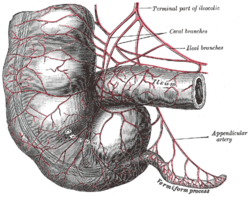虫垂
Jump to navigation
Jump to search
See also: 蟲垂
Japanese
[edit]
| Kanji in this term | |
|---|---|
| 虫 | 垂 |
| ちゅう Grade: 1 |
すい Grade: 6 |
| kan'on | |
| Alternative spelling |
|---|
| 蟲垂 (kyūjitai) |
Etymology
[edit]Appears to be a coinage in Japanese as a compound of 虫 (chū, “worm”) + 垂 (sui, “appendix (anatomy)”), replacing earlier 虫様突起 (chūyō tokki, “vermiform process”).[1]
It seems that the 突起 (tokki, “protrusion; protuberance; process”) portion in the older term was first replaced with 垂 (sui, “dangling; hanging (from something); appendix”) as 虫様垂 (chūyō sui, literally “worm-shaped dangling → vermiform appendix”), which in turn was shortened to modern 虫垂 (chūsui).
Compare Dutch wormvormig aanhangsel, English vermiform appendix.
Pronunciation
[edit]Noun
[edit]- (anatomy) an appendix, a vermiform appendix
Usage notes
[edit]In informal usage, the term 盲腸 (mōchō) is more common. In medical contexts, 虫垂 (chūsui) is preferred, as 盲腸 (mōchō) refers more specifically to the caecum instead of the appendix.
Derived terms
[edit]- 虫垂炎 (chūsuien): appendicitis
References
[edit]- ↑ 1.0 1.1 Kindaichi, Kyōsuke et al., editors (1997), 新明解国語辞典 [Shin Meikai Kokugo Jiten] (in Japanese), Fifth edition, Tokyo: Sanseidō, →ISBN
- ^ Matsumura, Akira, editor (2006), 大辞林 [Daijirin] (in Japanese), Third edition, Tokyo: Sanseidō, →ISBN
- ^ NHK Broadcasting Culture Research Institute, editor (1998), NHK日本語発音アクセント辞典 [NHK Japanese Pronunciation Accent Dictionary] (in Japanese), Tokyo: NHK Publishing, Inc., →ISBN
Categories:
- Japanese terms spelled with 虫 read as ちゅう
- Japanese terms spelled with 垂 read as すい
- Japanese terms read with kan'on
- Japanese compound terms
- Japanese terms with IPA pronunciation
- Japanese lemmas
- Japanese nouns
- Japanese terms spelled with first grade kanji
- Japanese terms spelled with sixth grade kanji
- Japanese terms with 2 kanji
- ja:Anatomy
